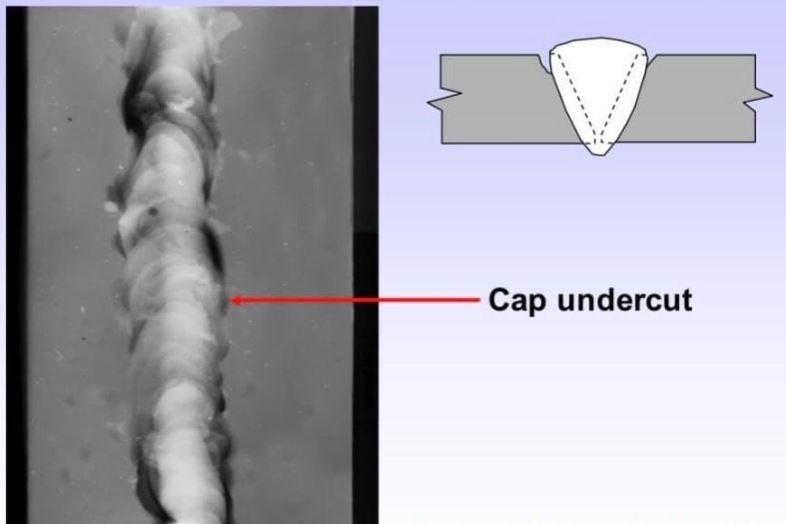Recognizing the Causes and Solutions for Undercut Welding in Steel Manufacture Procedures
In the world of steel manufacture procedures, the event of undercut welding postures a significant challenge that requires a comprehensive understanding of its causes and viable solutions. The intricate interplay of different elements during welding operations can lead to this unwanted sensation, affecting the architectural stability and overall top quality of the bonded joints - Preventing weld undercut. By exploring the source of undercut welding and checking out effective remedial steps, producers can raise the requirement of their workmanship and guarantee the manufacturing of remarkable metal components
Common Root Causes Of Undercut Welding
Regularly overlooked in steel fabrication, undercut welding happens due to different variables that require meticulous attention and know-how to be properly mitigated. Additionally, improper welding strategies, such as making use of the wrong welding angle or travel rate, can also contribute to damage development. The selection of welding parameters, such as voltage, current, and cable feed rate, plays a considerable function in the incident of undercut welding.
Effect of Incorrect Welding Parameters
Imprecise welding criteria can dramatically endanger the honesty and top quality of bonded joints in steel fabrication procedures. The influence of wrong welding specifications materializes in different ways, leading to architectural weak points and defects in the welded parts. One essential facet influenced by incorrect welding parameters is the penetration deepness of the weld. Not enough warm input due to low welding currents or excessively high traveling rates can lead to inadequate blend in between the base metals, leading to insufficient joint infiltration and damaged bonds. Alternatively, extreme heat input brought on by high welding currents or sluggish travel rates can cause too much and burn-through reinforcement, developing a weak and unpredictable weld structure. In addition, inaccurate parameters such as incorrect voltage settings or wrong electrode angles can contribute to irregular weld bead accounts, lack of fusion, and boosted chances of issues like undercutting. Meticulous interest to welding parameters is vital to make certain the manufacturing of high-quality welds with the preferred mechanical properties and structural stability.
Result of Improper Torch Angle
Improper lantern angle in welding procedures can substantially influence the quality and integrity of the final weld joints in metal manufacture procedures. Undercutting is a common welding defect where a groove forms along the weld toe, weakening the joint and endangering its architectural stability.
A lantern angle that is as well steep can lead to insufficient infiltration, insufficient combination, and increased spatter. On the various other hand, a lantern angle that is as well shallow can cause extreme penetration, burn-through, and distortion of the base product. Preventing weld undercut. Correct torch angle is important for ensuring regular weld quality, strength, and look
To avoid undercutting and various other flaws brought on by inappropriate lantern angles, welders must be educated to preserve the correct torch angle throughout the welding procedure. Regular tracking and adjustment of torch angles throughout welding can help attain sound welds with minimal flaws.
Role of Inadequate Welding Methods

One more element of inadequate welding techniques is improper weld preparation. Inadequate cleansing of the base steels, wrong joint layout, or not enough side preparation can all contribute to damage welding. Insufficient protecting gas coverage or using the incorrect type of gas can result in incomplete fusion and the development of undercut flaws.
To attend to the role of inadequate welding strategies in metal fabrication procedures, it is essential to give thorough training for welders. Appropriate education on welding parameters, joint prep work, and protecting gas selection can aid stop undercut welding and ensure high-quality welds in steel construction projects.
Efficient Solutions for Undercut Welding
Dealing with undercut welding in steel construction requires applying efficient solutions to boost weld high quality and architectural stability. Among the main services to battle undercut is to change welding parameters such as voltage, present, and take a trip rate to make sure proper warm input and fusion. By fine-tuning these settings, welders can protect against original site extreme melting of the base steel and filler material, lowering the possibility of undercut development.
Additionally, correct joint prep work is essential in protecting against undercut. Guaranteeing tidy base metal surfaces without pollutants and making use of the appropriate web link bevel angle can assist advertise better weld penetration and lower the danger of undercut - Preventing weld undercut. Using suitable welding methods, such as oscillating the lantern or weaving, can also help in dispersing heat evenly and filling up the weld joint sufficiently, decreasing the possibility of undercut problems
Moreover, picking the appropriate welding consumables, including electrodes and filler steels, is crucial in mitigating undercut. Utilizing materials with proper chemical make-ups and mechanical properties can add to accomplishing sound welds with very little undercut. Routine evaluation and quality control measures ought to likewise be executed to find and attend to undercut concerns without delay, making certain the total honesty of made steel elements.

Verdict
In verdict, recognizing the reasons and options for undercut welding in metal fabrication processes is crucial for try this web-site achieving high-quality welds. By resolving typical causes such as incorrect welding parameters, inappropriate lantern angle, and insufficient welding techniques, welders can prevent damaging and make certain strong, resilient welds. It is necessary to focus on these variables and apply efficient solutions to boost the general welding process and end product quality.
